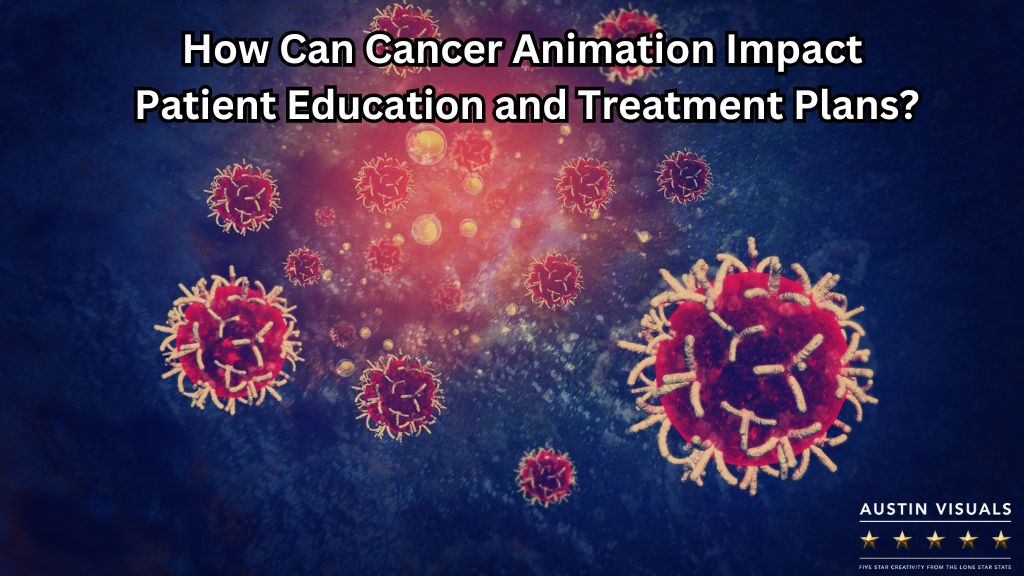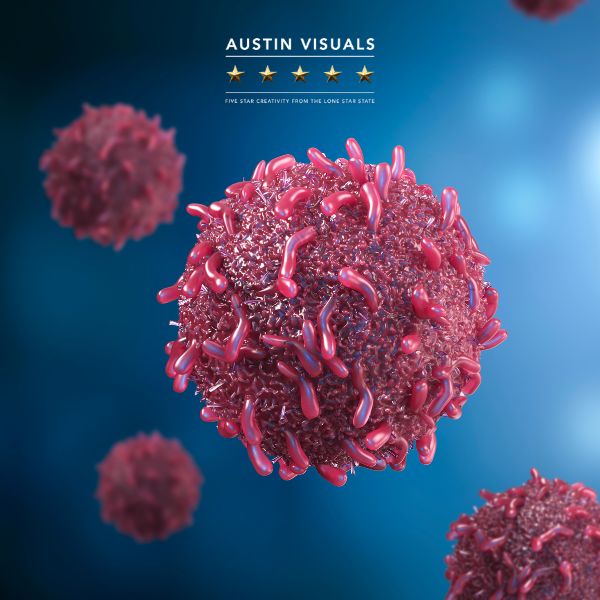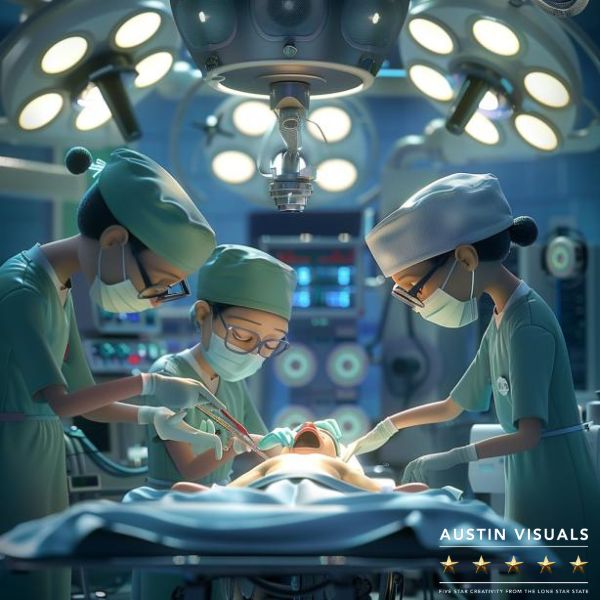
Contents
ToggleIntroduction to Cancer Animation
Cancer animation simplifies complex medical concepts into clear, engaging visuals. These animations illustrate cancer’s cellular mechanisms, aiding both patients and medical professionals by providing an accessible view of intricate processes.
In medical communication, visuals are indispensable—particularly in oncology. By presenting detailed medical information through animations, we can enhance comprehension and retention. This visual approach supports more effective discussions between patients and healthcare providers, enabling better understanding and engagement with treatment processes.
For more detailed information or to discuss how cancer animation can benefit your educational or communication strategies, contact Austin Visuals. Email us at [email protected] or call us at +1-512-591-8024. Explore our portfolio at www.austinvisuals.com and www.medical3danimationcompany.com to see the range of solutions we offer.
Our clients include:
The Evolution of Animation in Medical Fields
Historical Milestones
The journey of medical animation began with simple 2D illustrations and has evolved into complex 3D representations that offer dynamic insights into cellular processes. Particularly in oncology, these advancements have revolutionized patient education and professional training. Early animations were limited in detail and scope, but over the decades, as technology advanced, so did the capacity to depict accurate and detailed representations of cancer’s progression and treatment.
Technological Advances Enhancing Cancer Animation
Recent years have seen significant technological innovations that have dramatically enhanced the quality and accessibility of cancer animations. High-resolution imaging, real-time rendering, and interactive elements are now integral components of medical animation. These advancements allow for more precise and detailed visualizations of cancerous cells and treatments, making complex information more accessible to a non-specialist audience. This technological evolution not only improves the learning experience but also empowers patients and medical professionals to interact with the data in more meaningful ways.

Cancer Animation – Austinvisuals
Benefits of Cancer Animation in Patient Care
Simplifying Complex Information
Cancer animations serve as a bridge, turning intricate medical concepts into digestible visual narratives that patients can easily grasp. By animating the processes of cancer development, treatment options, and potential side effects, these animations demystify the complexities of oncology. This approach not only enhances understanding but also helps in reducing the overwhelming nature of a cancer diagnosis, making the information less intimidating and more accessible.
Visual Learning vs. Traditional Methods
Visual learning through animation has proven to be significantly more effective than traditional educational methods, such as textual content or static diagrams, especially in patient education. Animations engage multiple senses, aiding in better retention and understanding of the information. They can illustrate the dynamic processes of cancer in a way that books or oral explanations cannot match. Studies have shown that patients who receive information via animations report higher satisfaction levels and a better grasp of their treatment process compared to those who receive standard brochures or verbal explanations alone. This efficacy highlights the critical role of animation in enhancing patient understanding and participation in their own care plans.
Application of Cancer Animations in Treatment Planning
Role in Patient Consultations
Cancer animations play a pivotal role in enhancing the dynamics of patient consultations. By integrating detailed animations into discussions, physicians can clearly depict the growth, spread, and potential regression of tumors in a way that is visually comprehensible for patients. This visual method helps demystify complex medical jargon and processes, making it easier for patients to follow and engage in their treatment discussions. As a result, these animations serve as crucial tools in bridging the communication gap between medical professionals and patients, ensuring that discussions are more informative and less intimidating.
Support in Treatment Decision-Making
In the realm of treatment decision-making, cancer animations prove to be invaluable. They offer patients a visual understanding of different treatment pathways, including surgical procedures, chemotherapy, and radiation therapy, and the effects these may have on the body. By seeing a visual representation, patients can better grasp what to expect from each option, aiding them in making informed decisions about their care. This not only empowers patients but also fosters a sense of collaboration with their healthcare providers, enhancing trust and confidence in the chosen treatment plan. These visual aids have been shown to reduce decisional conflicts, making them essential tools in patient-centered care.
Real-World Examples of Cancer Animation
Case Studies of Cancer Animation in Action
Cancer animations have transformed patient care across various medical settings, serving as vital educational and communicative tools. For instance, at a leading cancer treatment center, animations illustrating the progression of pancreatic cancer have significantly improved patients’ understanding of their diagnosis and treatment plan. These visual tools help clarify the stages of cancer, the impact of different therapies, and potential outcomes, making complex medical information more accessible and less daunting for patients and their families.
Testimonials and Feedback from Medical Professionals
Feedback from healthcare professionals underscores the profound impact of cancer animations. Dr. Jane Smith, an oncologist, noted, “The use of detailed animations has revolutionized how we explain complex procedures to patients. It not only enhances their understanding but also helps in managing their expectations and anxiety.” Similarly, a surgical oncologist commented, “Animations have allowed us to visually demonstrate surgical techniques and post-surgery recovery processes, significantly improving patient comfort and confidence before going into surgery.” These testimonials highlight the crucial role animations play in enhancing communication and trust between medical professionals and patients.
Why Choose Austin Visuals for Your Cancer Animation Project
Choosing Austin Visuals 3D Animation Studio for your cancer animation project means partnering with a leader in medical animation. We blend artistic creativity with medical accuracy to produce impactful educational content that enhances patient understanding and engagement. Here are the key reasons to choose us:
- Expertise in Medical Animation: Our team deeply understands medical content, ensuring accuracy and relevance.
- Customized Solutions: We tailor animations to meet the specific needs of your audience, whether for patients or professionals.
- Advanced Technology: We use the latest tools to create vivid, engaging animations that simplify complex concepts.
- Collaborative Approach: We work closely with healthcare professionals to make sure our animations are both informative and practical.
- Proven Impact: Our animations are designed to improve comprehension and decision-making, enhancing both patient care and medical training.
Austin Visuals offers a range of specialized services in the medical field, including:
- Medical Animation: Creating detailed and accurate 3D animations to illustrate complex medical processes and concepts.
- Surgical Simulation: Providing visual simulations of surgical procedures for training and educational purposes.
- Pharmaceutical Mechanisms of Action (MOA): Animations that explain the mechanism of action of various drugs.
- Patient Education Videos: Custom videos designed to inform patients about diseases, treatments, and health maintenance.
- Virtual Reality (VR) Experiences: Developing immersive VR content for medical training and patient experience enhancement.
- Augmented Reality (AR) Applications: Utilizing AR for interactive medical and healthcare training tools.
- Interactive 3D Models: Offering dynamic 3D models for deeper understanding of anatomical and cellular structures.
- Dental Animation: Specialized animations to demonstrate dental procedures and promote dental health education.
Our showreel:
Future of Cancer Animation
Trends and Predictions in Medical Animation
As we look ahead, the landscape of medical animation, especially in oncology, is poised to undergo significant transformations, driven by advancements in technology. The integration of artificial intelligence (AI) and machine learning into cancer animations is expected to refine their accuracy and interactivity. AI algorithms can assist in creating more personalized animation experiences by analyzing patient data to tailor visualizations that are specific to an individual’s condition. Furthermore, machine learning could enable these tools to predict the progression of cancer based on historical health data, providing both patients and doctors with invaluable insights into treatment possibilities and outcomes.
The Expanding Scope of Animation in Healthcare
Beyond oncology, the application of animation is expanding across various medical disciplines, revolutionizing patient education and healthcare communication. For example, animations are being used to demonstrate cardiovascular procedures and explain the impacts of chronic diseases like diabetes in a more intuitive way. This broadening scope reflects a growing recognition of the value that visual learning brings to patient care, making complex medical information more accessible and digestible. As these technologies continue to evolve, we can expect to see an increase in their use in mental health education, physiotherapy, and preventive medicine, enhancing patient engagement and empowerment across the healthcare spectrum.






